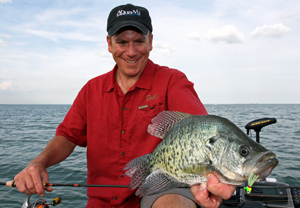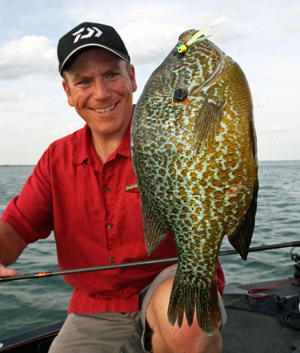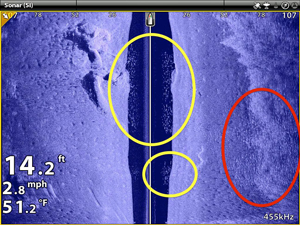Fishing Article: Big Water Panfish
Spring to Summer Sleuthing for Sunfish, Crappies and Perch! Ted Pilgrim with Joe BalogIt’s one thing to find spring and summer panfish in a pond, creek or small lake. But what do you do when your home water is one of the Great Lakes? Or a giant reservoir? Or a sprawling water body best known for bass, walleyes, trout or other predators? Good news pan’ fans. Even on big water, finding sunfish, crappies and even perch can be simpler than you think. And once you find them, these sweet species can be among the most palm-stretching specimens found anywhere. Big water bass pro Joe Balog also extols the virtues of finding giant panfish in a maze of freshwater. Photo courtesy of Aqua-Vu |
 Even on big lakes, crappies and other panfish can always be located in small bays, coves and manmade marinas, often all year around. Photo courtesy of Millennium Promotions |
Marina CrappiesOn some of these same days—when water temps linger in the low to mid 60s— Balog’s boat often slips inside one of St. Clair or Erie’s manmade harbors. Here, the usual suspects are big black and white crappies, as well as sunfish and the occasional ponderous perch. Crappies, however, provide the most consistent fishing. “Crappies live in some of these deepwater marinas all year long,” Balog notes, “as well as in many of the channels and canals on St. Clair’s north end. “In the marinas, it’s funny how crappies can be real picky about which stretch of docks or pilings they relate to, or even spawn on. A great method for locating the exact position of the fish is to use an Aqua-Vu Micro Camera. I like to mount the camera on a telescopic painter’s pole (10 to 15 feet long), and periscope under docks, large boats and around concrete or metal pilings. Crappies often cling super tight to specific objects, and often won’t budge more than a foot or two to grab a lure. Once I identify the types of cover the fish are using, and how they’re positioned on it, I can usually catch them with tubes, slip bobbers or little hair jigs.” |
The Fishrapper, Fishing Blue Books, LLC - 44076 Co Rd 128, Deer River, MN 56636
218-246-2375 copyright©2016 Fishing Blue Books, LLC All Rights Reserved - last revised 01/05/2017
Current Fishing Reports • Current Video • Fishing Articles • Links • Contact



